
Biomedical
SIFT-MS has diverse biomedical research applications from breath research to headspace analysis of microbes, body fluids and tissues.
Volatile compounds, individually or as a profile, can indicate health status of humans and other organisms.
SIFT-MS speeds up analysis time in both breath research and microbial metabolic process profiling. Breath research data can be used for population screening and to monitor temporal changes in breath volatiles.
High-sensitivity, direct analysis of diverse breath biomarkers
SIFT-MS provides rapid, high-sensitivity analysis of VOCs and inorganic gases on breath with no sample preparation and no compound discrimination, making it ideal for breath research applications.
Benefits include:
- Real-time analysis of individual breath exhalations
- Analytical results unaffected by sample humidity – no sample drying is required
- Very wide linear and dynamic range
- Flexibility – analyze directly or via sampling media, such as sampling bags
Applications of SIFT-MS-based breath analysis include:
- Disease marker screening
- Kidney medicine
- Non-invasive diabetes screening
- Respiratory medicine
- Intensive care medicine
- Monitoring anesthetics during surgery
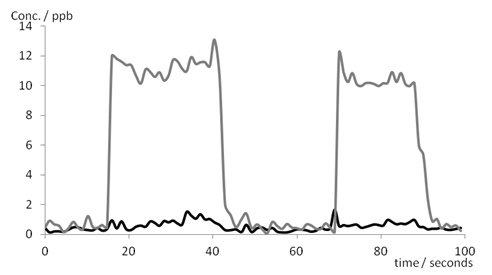
Single breath SIFT-MS analysis for hydrogen cyanide (gray) and hydrogen sulfide (black).
Find out more about SIFT-MS capabilities in Biomedical
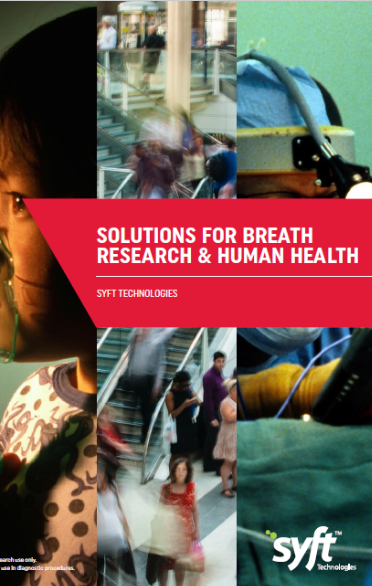
Healthcare Solutions by SIFT-MS
This brochure outlines several SIFT-MS based breath and medical research solutions provided by Syft Technologies. Real-time results are provided to diverse breath and microbial research applications, including non-invasive population screening, breath VOCs monitoring, and the rapid identification of microorganisms by their VOC fingerprints.
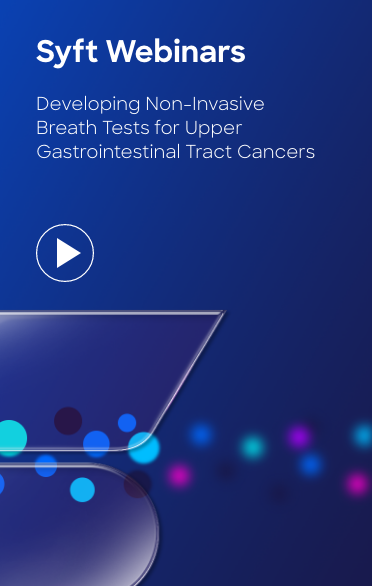
Developing Non-Invasive Breath Tests for Upper Gastrointestinal Tract Cancers
In this webinar, we describe:
• Why early detection of gastro-esophageal cancers is so challenging
• Research utilizing SIFT-MS, with potential screening applications
• Future external validation work using Thermal Desorption-SIFT-MS
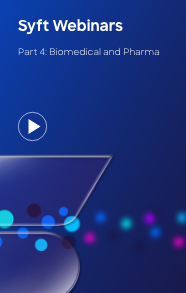
Part 4: Biomedical and Pharma
In this webinar, we describe the wide range of biomedical and pharmaceutical applications in which SIFT-MS solves difficult analytical challenges. These include:
- Breath research, for which there is a significant academic literature
- Analysis of body fluid headspace
- Microbial VOC analysis
- Emerging small-molecule applications for the pharma industry
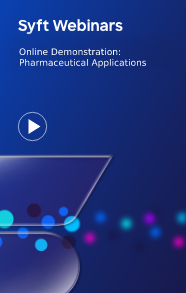
Online Demonstration: Pharmaceutical Applications
This workshop includes:
- An overview of the current industries that are using SIFT-MS and the companies that are benefiting from it
- What distinguishes SIFT-MS from other mass spectrometry techniques
- Where and how SIFT-MS applies in the pharmaceutical industry
- Live demonstrations: using SIFT-MS to analyze various samples
- Breakdown of sample analysis, including Syft Technologies' custom software that displays data in real-time.
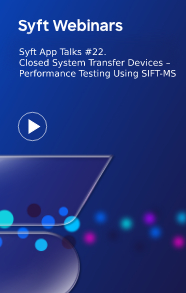
Syft App Talks #22. Closed System Transfer Devices – Performance Testing Using SIFT-MS
Dr. Mark Perkins (Anatune Limited, UK) and Alan Wilkinson (Biopharma Stability Testing Laboratory, UK) collaborated to evaluate SIFT-MS for determination of CSTDs using protocols previously developed by NIOSH (USA). Using propylene glycol methyl ether (PGME) as a surrogate, SIFT-MS detects sub-microlitre volume leaks from these devices.
Join this Syft Application Talk presented by Mark Perkins to learn more!
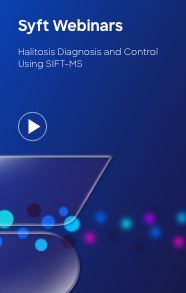
Halitosis Diagnosis and Control Using SIFT-MS
We have used SIFT-MS for the analysis of volatiles from in vitro biofilm cultures inoculated with human tongue-derived biofilm prior to and following treatment with anti-malodor formulations. We have also used the SIFT-MS in clinical trial settings to measure the efficacy of a wide range of oral care products. This webinar will present the application of the SIFT-MS in halitosis research including current and future trends.
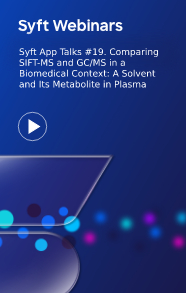
Syft App Talks #19. Comparing SIFT-MS and GC/MS in a Biomedical Context: A Solvent and Its Metabolite in Plasma
Self-poisoning with professional agricultural pesticide products is responsible for about 20% of global suicide. Fast detection could aid earlier identification of pesticide poisoning thus allowing faster intervention, reducing mortality. We compare analysis by both automated headspace GC/MS and SIFT-MS. The results obtained showed a four-fold increase in throughput for SIFT-MS over GC/MS.
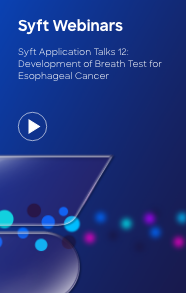
Syft Application Talks 12: Development of Breath Test for Esophageal Cancer
Who could be better qualified to explain the need for improved outcomes for people with upper gastrointestinal (GI) cancers than renowned surgeon, researcher, and head of Imperial College’s Department Surgery and Cancer, Professor George Hanna? Prof. Hanna joined us at the 2020 European Online SIFT-MS User Meeting to describe his group’s breath research targeted at identifying upper GI cancers earlier. His work is reviewed and upcoming external validation studies are outlined.
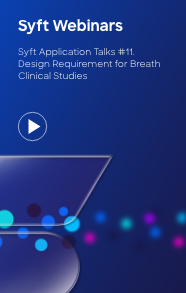
Syft Application Talks #11. Design Requirement for Breath Clinical Studies
SIFT-MS’s high-throughput analysis of breath (whether directly, from sampling bags, or from thermal desorption tubes) means that it is an ideal instrument for breath research. In this presentation, Professor Hanna summarizes what he and his research team have implemented in terms of best practices based on years of breath research.
Syft Tracer: The Next Generation of Volatile Impurities Analysis for Enhanced Workflows
This app note introduces the next generation of SIFT-MS, Syft TracerTM, which launched at Pittcon 2023. It revolutionizes volatile impurities analysis workflows through unparalleled speed, performance stability, and reproducibility. Learn about how this innovation to real-time trace gas detection outpaces chromatography-based methods in the analysis of challenging analytes such as formaldehyde in a PEG excipient.
Head to Head Comparison of Class 2A And 2B Residual Solvents Analysis Using Sift-MS And GC-FID
This application note describes head-to-head comparison of GC-FID and SIFT-MS analyses of Class 2A and 2B residual solvents. The techniques perform similarly for linearity and repeatability, but SIFT-MS provides superior performance for accuracy and recovery. Furthermore, SIFT-MS provides greater than 11-fold increase in sample throughput and significantly reduces the time taken to report quantitative results (over six times faster for a full calibration set).
Recent developments and applications of selected ion flow tube mass spectrometry (SIFT‐MS)
SIFT‐MS is now recognized as the most versatile analytical technique for the identification and quantification of trace gases down to the parts‐per‐trillion by volume, pptv, range. This statement is supported by the wide reach of its applications, from real‐time analysis, obviating sample collection of very humid exhaled breath, to its adoption in industrial scenarios for air quality monitoring. This review touches on the recent extensions to the underpinning ion chemistry kinetics library and the alternative challenge of using nitrogen carrier gas instead of helium.
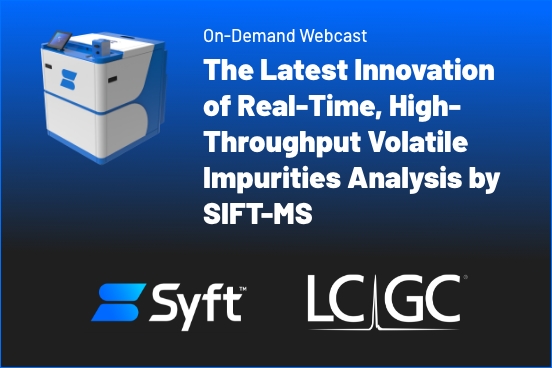
The Latest Innovation of Real-Time, High-Throughput Volatile Impurities Analysis by SIFT-MS
Join us for this webinar to learn about Syft Tracer, the latest advancement of real-time, trace gas analysis by SIFT-MS which launched at Pittcon 2023. Hear how the recent product innovations unlock analytical bottlenecks and enable faster decisions to be made in critical process steps.
Syft Tracer Brochure
Syft TracerTM is the latest advancement in real-time, direct injection mass spectrometry (MS) built to solve the most difficult analytical challenges faced within a variety of industries and applications. This advancement to SIFT-MS delivers trace-level detection sensitivity, unparalleled performance stability, superior selectivity, and highly reproducible, quantitative data. Syft Tracer is optimized for high-throughput environments where continuous operation is the standard. Never miss a product or environmental contamination event again.
Even Faster Quantitation Of Formaldehyde In Gelucire Excipient
This application note describes how the efficiency of a MHE workflow can be significantly improved for MHE-SIFT-MS due to the stability of the technique. Formaldehyde impurity is analyzed easily and quantitatively in Gelucire excipient with this improved approach. The time-to-result is reduced to 85 minutes for this system – six-fold faster than the conventional MHE-SIFT-MS approach. Quantitative analysis is achieved at the throughput of 220 samples/day.
Revolutionary Productivity For Volatile Residue and Impurity Analysis
This application note describes a scenario in which Syft TracerTM replaces five chromatography systems and still has significant available sample capacity. SIFT-MS provides rapid, chromatography-free analysis that revolutionizes multiple workflows.
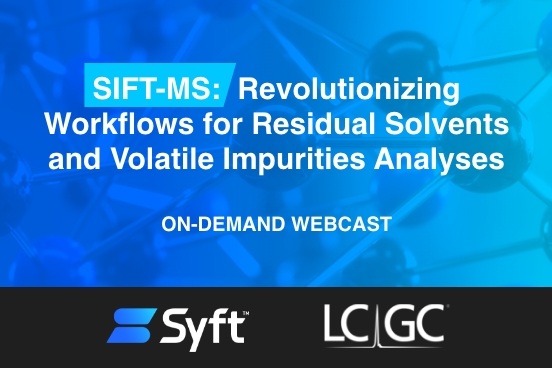
Revolutionizing Workflows for Residual Solvents and Volatile Impurities Analyses by SIFT-MS
This webinar demonstrates how the new, automated Syft TracerTM SIFT-MS platform provides a comprehensive solution to workflow challenges and can replace multiple chromatographic systems. Learn about how combining SIFT-MS with automation provides a very flexible and high throughput solution for screening volatile impurities in pharmaceutical and consumer safety applications, revolutionizing workflows.
Revolutionizing Volatile Impurities Analysis Through Next Gen SIFT-MS
This E-book describes how next gen SIFT-MS enables rapid, continuous screening of toxic volatile impurities in pharmaceutical and consumer products. This advancement to SIFT-MS delivers trace-level detection sensitivity, unparalleled performance stability, superior selectivity, and highly reproducible, quantitative data. Never miss a contamination event again.
Improved MHE-SIFT-MS Workflows - Concentration Independent MHE Calibration
This application note investigates concentration dependence of MHE calibration in sample matrix. Across the full range of analytes investigated in this study, MHE calibration holds for at least one order of magnitude change in sample concentration. For analytes in the C7–C9 range, the MHE calibration applies over two orders of magnitude analyte concentration. These results mean that the MHE workflow can be applied to a wider range of samples in the matrix, further reducing calibration demand.